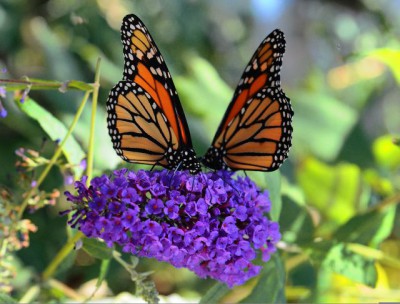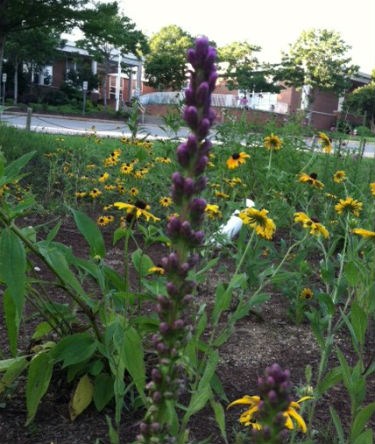
HOLLY RIDGE — It is a tale as old as time — the story of the birds and the bees. Well. bees, anyway.
Since the beginning, humans have relied on a partnership with nature to survive. So it is only natural that when the tiniest workers in the human food chain are in danger, it is time to give them a little helping hand.
Supporter Spotlight
That’s exactly what the students at Dixon Elementary School in Holly Ridge intend to do this spring.
Onslow County’s Dixon Elementary will be home to a new quarter-acre pollinator garden for bees and butterflies, thanks to a partnership with their neighbors at the N.C. Coastal Land Trust. The students will plant native grasses and pollinators like milkweed, asters, purple coneflower, Indian grass, bee balm and wild indigo.
Teacher Kristen McCutcheon is excited about the project. “This is more than a garden. This project has given select students in first through third grade a wonderful opportunity to solve real world sustainability issues,” she said.
“Taking this piece of overgrown land and turning it into something beautiful is a learning experience that will become a lasting memory for these children. And hopefully even for some, be the start of a budding love and interest for the environment around them,” McCutcheon said.
Janice Allen, deputy director of the land trust agrees. “We are very pleased to work with our neighbor to create the pollinator garden,” she said. “It is a great way to get kids involved with nature.”
Supporter Spotlight
The land trust owns a 250-acre tract along Everett Creek, across the road from the school. Much of the property is currently being restored to a longleaf pine forest. Now, the land trust will add a pollinator garden as well.
Allen hopes that the partnership will expand to include the school using the Everett Creek property as an outdoor classroom. “The land will serve the extended community as a nature preserve, so it is only natural that it be used for elementary education,” she said.
Recent statistics about the decline in pollinator species are daunting. Honeybee populations have been in steady decline for a decade, and just last year the number of Monarch butterflies migrating south has been the lowest ever recorded. As a result, in 2014, President Obama issued a memorandum to all federal agencies to promote the health of honeybees and other pollinators across the country.

“For Monarch populations to rebound, it is vital that we act now,” said John Ann Shearer, N.C. coordinator for the U.S. Fish and Wildlife Services. “So much of their habitat has been lost in our state due to development and regular mowing.”
The Fish and Wildlife Services works regularly with the land trust and is chipping in on the pollinator gardens.
“We were already working with the land trust to restore longleaf pine on private lands,” said Shearer. “We were able to add $33,000 to that cooperative agreement this past December to fund several projects to create pollinator gardens and in particular, to provide milkweed for Monarch butterflies.”
Pollinator gardens that include milkweed plants provide habitats for the Monarchs to reproduce. Other native pollinator plants provide essential food for the migrating butterflies. Shearer says, “Across the state, the gardens will provide essential habitats but also serve to support educational and outreach efforts associated with pollinator habitats.”
The land trust is heading up the statewide effort and will distribute money to other groups as part of the mission. The North Carolina Botanical Garden will propagate native milkweed plants for planting across the state. The garden also owns undeveloped land in the Piedmont, where they will plant milkweed plugs.
Other partners include the N.C. Wildlife Resources Commission and Wake County and Raleigh parks and recreation departments. These groups will receive milkweed plants to place in existing fields, under power lines and along the edges of streams and rivers. At least 30 acres will be planted, mostly by volunteers. Educational materials will also be developed as well.
In rural Montgomery County, the federal-state partnership will develop butterfly and insect habitats along a community walking trail at Star Works Center for Creative Enterprises. The garden plantings will include a mixture of native grasses and wildflowers, with the specific focus on milkweed to benefit Monarchs.
In Mecklenburg County, the parks and recreation department will plant milkweed plugs to enhance 30 acres of prairie habitats owned and managed by Mecklenburg County Natural Resources and along county rights-of-way. They will continue to manage and maintain these areas as pollinator habitat into the future. Youth programs at the County Interpretive Center will focus on Monarchs and the importance of milkweed plants.
“Growing milkweed in old fields and meadows and even in small gardens can provide more habitat for Monarch butterflies,” explained Shearer. “Everything we can do to educate the public about the importance of preserving pollinator species will help to increase their numbers in North Carolina.”
A music video featuring the U.S. Army Strings playing Rimsky-Korsakov’s famous “Flight of the Bumblebee,” featuring very active bumblebees.
Shearer is excited about this new team effort. “It amazes me how they continue to find opportunities to encourage landowners to return the land to its natural condition for the benefit of native wildlife and their willingness to support Monarch projects across the state is a fine example of their commitment to native habitats,” he said.
Back in Holly Ridge, the students at Dixon Elementary are ready for spring. “It has been a long, cold winter,” McCutcheon laughed. “We’re all excited to begin planting these pollinator plants in the classroom. By charting plant growth and making observations of our pollinators it will give us a little look at what we are about to accomplish with our partnership with the N.C. Coastal Land Trust.”
To prepare for the project, students will plant seeds supplied by Mellow Marsh Farm in Siler City. “The mix that we were given is going to be a science experiment in itself. The students have pictures of what the plants look like from seed all the way to the full-grown specimens,” McCutcheon explained. “It will be up to them to determine the type of plant that is in each pot as it grows. Through careful observation, compare and contrast, and using deductive reasoning they will be taking on the role of wildlife experts in the classroom,”
“We are working with the County Cooperative Extension to prep the soil for this project,” said Jennifer Avesing, the land trust biologist who is working closely with McCutcheon on the Dixon garden. “Now it is time to get to work — the kids are ready to get outside and get their hands dirty.”








